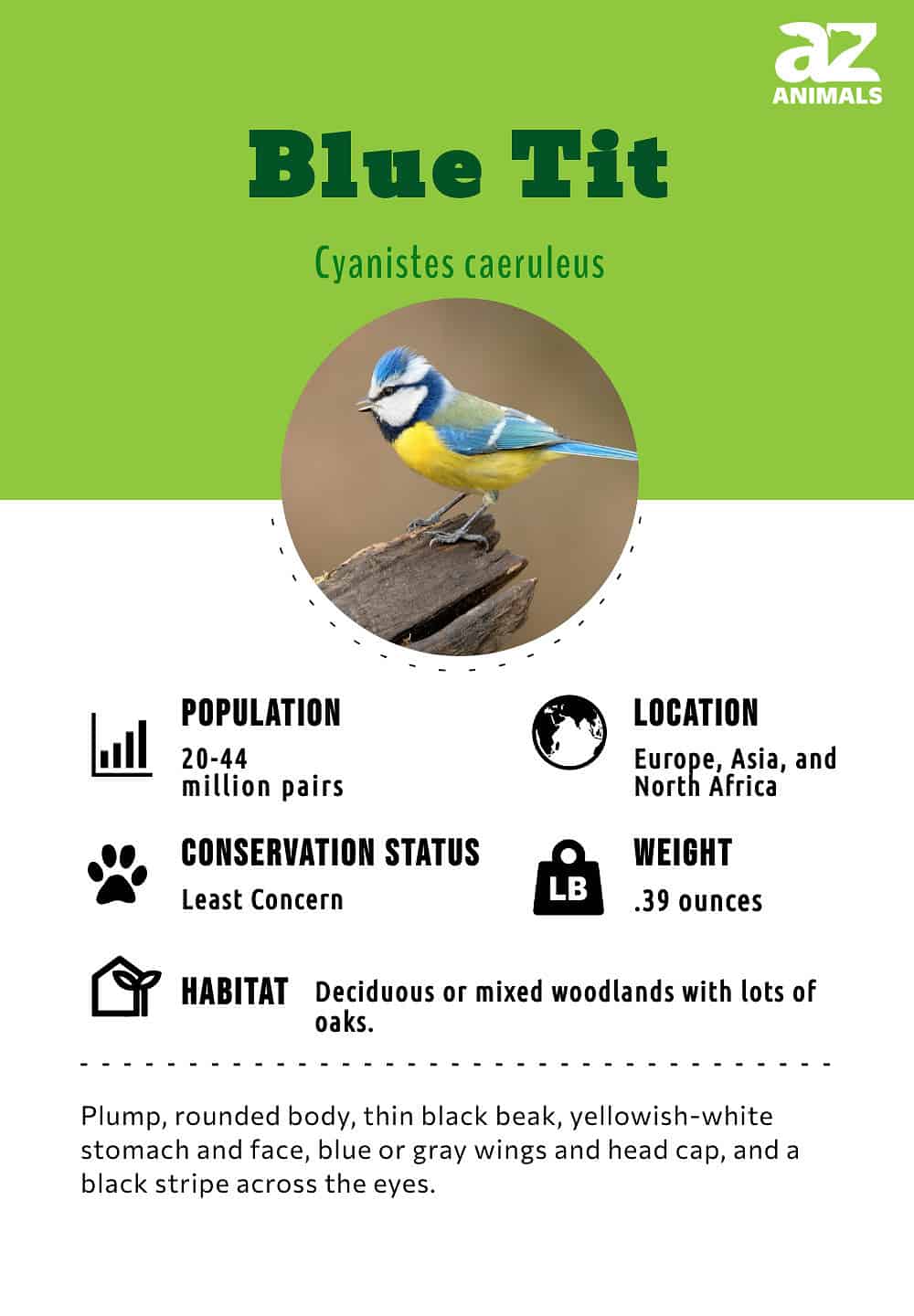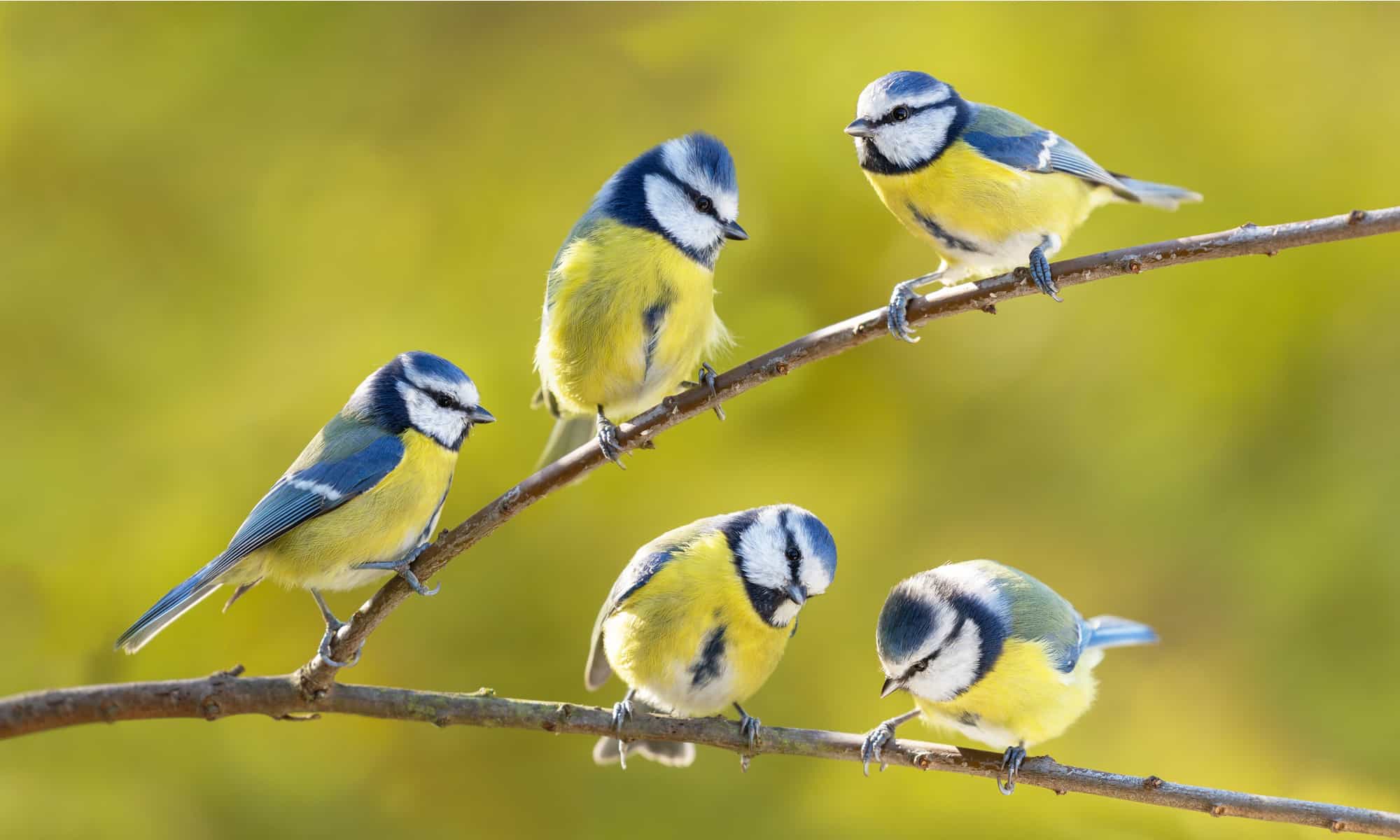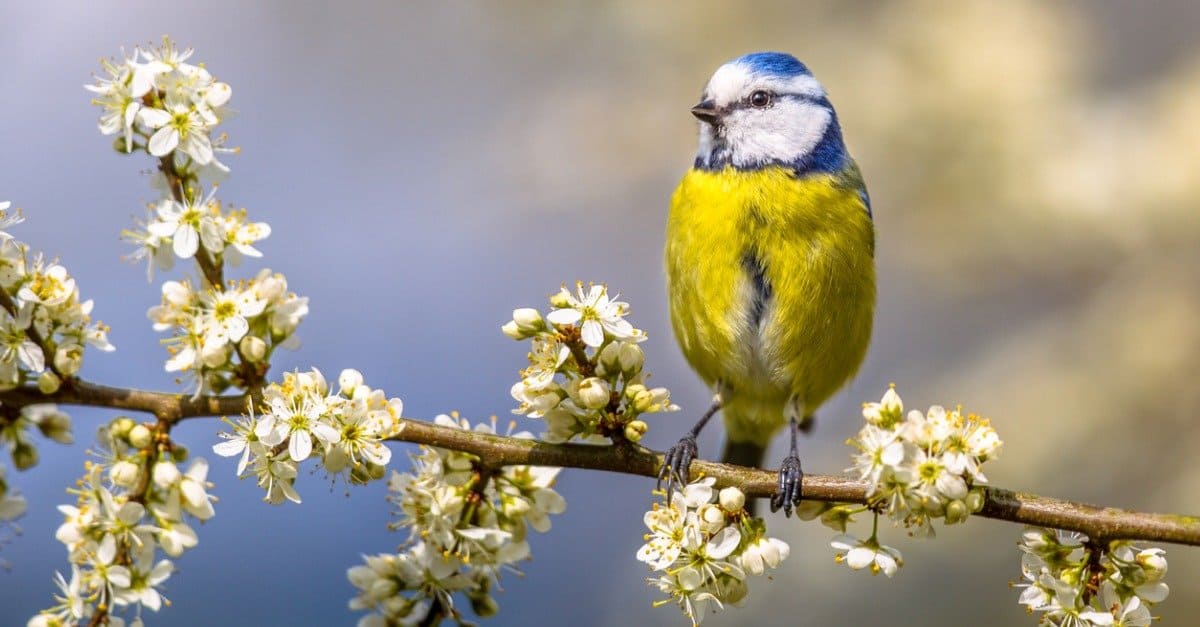Blue Tit
Cyanistes caeruleus
The blue tit can hang upside down from branches
Advertisement
Blue Tit Scientific Classification
- Kingdom
- Animalia
- Phylum
- Chordata
- Class
- Aves
- Order
- Passeriformes
- Family
- Paridae
- Genus
- Cyanistes
- Scientific Name
- Cyanistes caeruleus
Read our Complete Guide to Classification of Animals.
Blue Tit Conservation Status
Blue Tit Facts
- Prey
- Insects, spiders, fruits, and seeds
- Fun Fact
- The blue tit can hang upside down from branches
- Estimated Population Size
- 20-44 million pairs
- Biggest Threat
- Habitat loss
- Most Distinctive Feature
- The bright blue crown and black eye stripe
- Other Name(s)
- Blue cap or blue bonnet
- Wingspan
- 18cm (7in)
- Incubation Period
- 16 days
- Habitat
- Woodlands, hedgerows, parks, and gardens
- Predators
- Cats, sparrowhawks, squirrels, and weasels
- Diet
- Omnivore
- Type
- Bird
- Common Name
- Blue Tit
- Number Of Species
- 3
- Location
- Europe, Asia, and Africa
- Nesting Location
- Holes in trees, walls, or nest boxes
- Age of Molting
- 3 weeks
- Migratory
- 1
View all of the Blue Tit images!
The blue tit is a yellow-breasted songbird with a loud singing voice and charismatic personality. It is one of the most common songbirds in all of Europe.

“Blue tit” may refer to a few different species: the Eurasian blue tit, the African blue tit, or the azure tit. For the purpose of this article, the Eurasian blue tit will be the main subject, but the African blue tit and azure tit will be covered as well. You can attract blue tits to your yard with a bird feeder, plenty of fresh water, and a nest box with a 1-inch hole. Blue tits often compete for food and nesting sites with the great tit, which they resemble.
3 Blue Tit Amazing Facts
- The Eurasian blue tit is apparently capable of interbreeding with the azure tit in western Russia to produce viable offspring. The resulting hybrid is known as Pleske’s tit.
- Blue tits are known for being incredible acrobats. They can hang upside down from branches to search for food.
- Blue tits can transmit knowledge from one generation to another. For example, one group of blue tits learned how to tear the foil cap off milk bottles and then passed down the knowledge to subsequent generations.
Scientific Name

The Blue Tit’s genus and species names are taken from the Greek and Latin words for dark blue.
©Coatesy/Shutterstock.com
The scientific name of the Eurasian blue tit is Cyanistes caeruleus. Both words basically refer to its color. Cyanistes is derived from the Greek word kuanos, meaning dark blue. The species name caeruleus comes from a Latin word meaning dark blue or azure. Blue tits belong to the Passeriformes order and the Paridae family, which includes titmice, chickadees, and other tits. The name tit in this case means something small. There are at least nine subspecies of the Eurasian blue tit currently recognized.
Size, Appearance, and Behavior
The blue tit is a small songbird with a plump, rounded body and thin black beak. It is characterized by a yellowish white stomach and face, blue or gray wings and head cap, and a black stripe across the eyes. Males and females look very similar to each other, but juveniles tend to have a dull gray appearance instead. These birds typically measure about 5 inches from head to tail with a wingspan of around 7 inches long. All three species look remarkably similar to each other, but the azure tit tends to have whiter plumage around the breast and head, while the African tit tends to have an even more pronounced yellow breast.

Blue Tits congregate together in the winter to roost and feed before branching off into breeding pairs for the spring and summer.
©Nitr/Shutterstock.com
Blue tits congregate together in mixed flocks for the winter to roost and feed, and then they will branch off into smaller breeding pairs for the spring and early summer. Male blue tits create songs to defend their territory or attract mates. The song consists of a high-pitching trilling sound that can be heard for a long distance all around it. Both males and females make a variety of other sounds, including alarm calls when a predator is near. As highly resourceful birds, they will nest in just about any suitable locations, including trees, walls, and nest boxes.
Location
The yellow-breasted Eurasian blue tit can be found across most of Europe and parts of Western Asia, whereas the African blue tit is endemic to Northern Africa. The azure tit is also native to Central Asia and Eastern Europe. Blue tits prefer deciduous or mixed woodlands with a particularly high number of oak trees in which to reside. They’re also found near hedgerows, parks, and gardens.
Diet

The Eurasian blue tit can hang upside down from almost anything to access food like insects and spiders.
©Rudmer Zwerver/Shutterstock.com
The blue tit is an omnivorous bird that spends a lot of time foraging on the ground or in trees. It can hang upside down from almost anything to access food.
The blue tit primarily feeds on insects and spiders. They will supplement this with fruits and seeds in the winter. The blue tit is considered to be an excellent pest controller given how many insects they consume for their small size.
Predators, Threats, and Conservation Status
According to the IUCN Redlist, the Eurasian blue tit is considered to be a species of least concern. These birds might be affected by habitat loss in some places, but numbers mostly appear to be on the rise throughout their natural range. Both the African blue tit and the azure tit are classified as least concern too.
Blue tits are primarily preyed upon by cats and sparrowhawks. Nests are also raided by squirrels and weasels in the spring. Groups of blue tits can mob a predator to drive it away.
Reproduction, Young, and Molting
The blue tit breeding season takes place every year between April and June. The male will attempt to attract a mate with his exuberant song.

The Blue Tit will make a nest in a tree hole or a birdhouse, if one is provided.
©stefbennett/Shutterstock.com
After choosing an appropriate nesting site in a tree hole, the female constructs the nest on her own from moss, feathers, and other soft materials. The male will trail close behind her to ensure that she does not mate with anyone else. The mother will lay a single egg per day at around 6 AM until she reaches a full clutch of up to 10 eggs. The size of the entire clutch can easily exceed her own body weight. She will incubate them for 16 days, while the male provides her with food.
After the chicks hatch, both parents work tirelessly to provide them with all the food they need to grow. It’s estimated that up to 10,000 caterpillars are required to rear a single brood. It takes around three weeks for the chicks to fully fledge and start to leave the nest. This is the only brood that the parents will produce that year. Due to predation and disease, most blue tits only live around three years. An unusually cold and wet spring or summer can also negatively affect population numbers by reducing the number of caterpillars available to eat. The record for the longest lifespan was more than 10 years old.
Population
The yellow-breasted Eurasian blue tit is estimated to have a total population of some 20 to 44 million pairs, and the numbers may be increasing. Because of its abundance, there are no special conservation programs devoted to this species. The number of African blue tits and azure tits are not well-known.
View all 285 animals that start with BBlue Tit FAQs (Frequently Asked Questions)
Does the blue tit migrate?
The blue tit does not migrate very far for the winter.
How many eggs does the blue tit lay?
The female lays a typical clutch of eight to 10 eggs per breeding season.
How fast does the blue tit fly?
The blue tit can fly at an estimated speed of around 20 miles per hour.
What is the blue tit’s wingspan?
The blue tit has a typical wingspan of approximately 7 inches long.
When do blue tits leave the nest?
They usually leave the nest at about three weeks old.
Are blue tits rare?
Blue tits are very common throughout their entire natural range. They can often be seen foraging near yards, parks, and gardens.
Where does a blue tit bird live?
The Eurasian blue tit lives in woodlands, hedgerows, and similar habitats throughout Europe and Western Asia.
How many blue tits are in the UK?
It’s estimated that there are some 3.3 to 3.4 million pairs of blue tits in the United Kingdom alone. They are protected by the government thanks to the Wildlife and Countryside Act of 1981.
Thank you for reading! Have some feedback for us? Contact the AZ Animals editorial team.
Sources
- , Available here: https://www.rspb.org.uk/birds-and-wildlife/wildlife-guides/bird-a-z/blue-tit/
- , Available here: https://www.discoverwildlife.com/animal-facts/birds/facts-about-blue-tits/

















